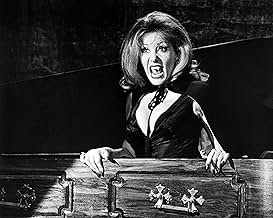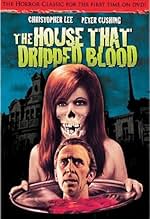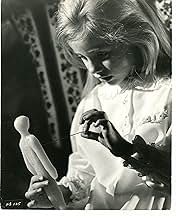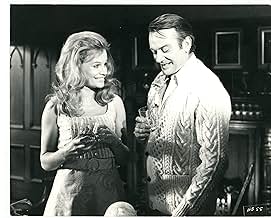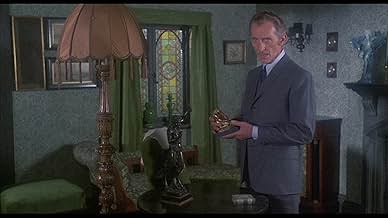ÉVALUATION IMDb
6,5/10
8,3 k
MA NOTE
Une anthologie de quatre histoires d'horreur autour d'une mystérieuse maison de location au Royaume-Uni.Une anthologie de quatre histoires d'horreur autour d'une mystérieuse maison de location au Royaume-Uni.Une anthologie de quatre histoires d'horreur autour d'une mystérieuse maison de location au Royaume-Uni.
Roy Beck
- Camera Crew
- (uncredited)
Avis en vedette
In the English countryside there stands a house, a seemingly benign, ramshackle abode nestled amid the undergrowth and enveloped in mystery. Unfortunate incidents occur to those who stay at the place, as a detective finds out while investigating the disappearance of its' latest dweller. While on the case, he hears of four separate tales of woe that befell those who rented the house, each more macabre and chilling than the last, in Peter Duffell's marvelous horror-comedy 'The House That Dripped Blood.'
An anthology film consisting of four separate stories concerning the titular homestead, 'The House That Dripped Blood' is vintage British horror. Written by Robert Bloch (and an uncredited Russ Jones), the tales within the film are each and all entertaining, full of suspense and chills. The segments vary both in tone and in quality, with the Christopher Lee led "Sweets To The Sweet" impressing and frightening the most, and Jon Pertwee's camp parody "The Cloak" being the weakest offering of the bunch. The other two, "Method For Murder" and 'Waxworks" have their moments, but don't match the sinister atmosphere and psychological terror of Lee's segment and seem unfortunately rushed to market.
In anthology films, it's not uncommon for segments to vary in length, but the first two seem far shorter than the last ones, and this imbalance produces jarring effects. "Method For Murder" and 'Waxworks" breeze by- and while the lengthy, penultimate "Sweets To The Sweet" works brilliantly- the final episode, "The Cloak," feels like it's dragging on in comparison to what came before it. Its considerably lighter tone also means that it feels somewhat inconsequential and pointless. The three preceding stories are full of dark, seedy horror that sometimes drifts into humorous territory; while "The Cloak" fully embraces the comedic and comes across as rather silly and facile.
Though still entertaining, as the whole film is overall- not to mention being technically polished. Ray Parslow's cinematography is striking, and while this isn't exactly a Dario Argento film; it's got an assured visual style that's most impressive. Credit for the film's look must also go to Tony Curtis, whose work as art director has produced distinct results. Additionally, the score from Michael Dress is atmospheric and foreboding, and Peter Tanner's editing is swift and seamless. For a relatively low-budget affair, 'The House That Dripped Blood' has a lot to offer viewers.
Including some fine performances from a large cast of talented actors. Denholm Elliott and Joanna Dunham do good work in "Method For Murder," with Elliott's portrayal of a man descending into madness being especially notable. Peter Cushing is terrific as a lonely man inexplicably drawn to a waxwork figure in "Waxworks," and is on screen for far too short a time. Christopher Lee dominates the film as an austere father in "Sweets To The Sweet," giving a performance both restrained and intense that lingers in the mind long after the credits have rolled. From "The Cloak," Ingrid Pitt does memorable work, though is underutilized and overshadowed by her screen partner; the miscast Jon Pertwee (in a role, one might add, tailored for Vincent Price, who would have been perfect).
'The House That Dripped Blood' is a highly enjoyable anthology film that will thrill and chill in equal measure. Well written by Robert Bloch and featuring stylish visuals and an emotive Michael Dress score, the film readily impresses. Though the segments vary in quality, all are entertaining and one- "Sweets To The Sweet"- is nothing short of brilliant. Boasting a cast of stars performing strongly and deft direction from Peter Duffell, 'The House That Dripped Blood' is a fantastic voyage of fun and fear that is sure to frighten, please and amuse.
An anthology film consisting of four separate stories concerning the titular homestead, 'The House That Dripped Blood' is vintage British horror. Written by Robert Bloch (and an uncredited Russ Jones), the tales within the film are each and all entertaining, full of suspense and chills. The segments vary both in tone and in quality, with the Christopher Lee led "Sweets To The Sweet" impressing and frightening the most, and Jon Pertwee's camp parody "The Cloak" being the weakest offering of the bunch. The other two, "Method For Murder" and 'Waxworks" have their moments, but don't match the sinister atmosphere and psychological terror of Lee's segment and seem unfortunately rushed to market.
In anthology films, it's not uncommon for segments to vary in length, but the first two seem far shorter than the last ones, and this imbalance produces jarring effects. "Method For Murder" and 'Waxworks" breeze by- and while the lengthy, penultimate "Sweets To The Sweet" works brilliantly- the final episode, "The Cloak," feels like it's dragging on in comparison to what came before it. Its considerably lighter tone also means that it feels somewhat inconsequential and pointless. The three preceding stories are full of dark, seedy horror that sometimes drifts into humorous territory; while "The Cloak" fully embraces the comedic and comes across as rather silly and facile.
Though still entertaining, as the whole film is overall- not to mention being technically polished. Ray Parslow's cinematography is striking, and while this isn't exactly a Dario Argento film; it's got an assured visual style that's most impressive. Credit for the film's look must also go to Tony Curtis, whose work as art director has produced distinct results. Additionally, the score from Michael Dress is atmospheric and foreboding, and Peter Tanner's editing is swift and seamless. For a relatively low-budget affair, 'The House That Dripped Blood' has a lot to offer viewers.
Including some fine performances from a large cast of talented actors. Denholm Elliott and Joanna Dunham do good work in "Method For Murder," with Elliott's portrayal of a man descending into madness being especially notable. Peter Cushing is terrific as a lonely man inexplicably drawn to a waxwork figure in "Waxworks," and is on screen for far too short a time. Christopher Lee dominates the film as an austere father in "Sweets To The Sweet," giving a performance both restrained and intense that lingers in the mind long after the credits have rolled. From "The Cloak," Ingrid Pitt does memorable work, though is underutilized and overshadowed by her screen partner; the miscast Jon Pertwee (in a role, one might add, tailored for Vincent Price, who would have been perfect).
'The House That Dripped Blood' is a highly enjoyable anthology film that will thrill and chill in equal measure. Well written by Robert Bloch and featuring stylish visuals and an emotive Michael Dress score, the film readily impresses. Though the segments vary in quality, all are entertaining and one- "Sweets To The Sweet"- is nothing short of brilliant. Boasting a cast of stars performing strongly and deft direction from Peter Duffell, 'The House That Dripped Blood' is a fantastic voyage of fun and fear that is sure to frighten, please and amuse.
Don't let the title fool you, there is no blood in this film. THE HOUSE THAT DRIPPED BLOOD is a rather tame, four part anthology film about an old manor, and the untimely deaths of its occupants.
First, Denholm Elliot is a horror writer who moves into the house seeking inspiration for his next book. He no sooner dreams up a creepy character, than it appears to have come alive!
Next, Peter Cushing visits a wax museum, only to find something quite unexpected concerning one of the figures.
In the third segment, Christopher Lee is either a heartless father to his young daughter, or she is far more than she appears to be.
Finally, John Pertwee is a jaded horror actor, who stumbles upon a certain, very familiar cape in an occult shop. Lighthearted terror and mirth ensue. Co-stars Ingrid Pitt!
The wraparound story has a Scotland Yard detective trying to solve these cases. Entertaining, though not very frightening, it's still good to see Cushing and Lee in anything!...
First, Denholm Elliot is a horror writer who moves into the house seeking inspiration for his next book. He no sooner dreams up a creepy character, than it appears to have come alive!
Next, Peter Cushing visits a wax museum, only to find something quite unexpected concerning one of the figures.
In the third segment, Christopher Lee is either a heartless father to his young daughter, or she is far more than she appears to be.
Finally, John Pertwee is a jaded horror actor, who stumbles upon a certain, very familiar cape in an occult shop. Lighthearted terror and mirth ensue. Co-stars Ingrid Pitt!
The wraparound story has a Scotland Yard detective trying to solve these cases. Entertaining, though not very frightening, it's still good to see Cushing and Lee in anything!...
The script of this ghoulish horror anthology is Robert Bloch at his diabolical best. I only saw this recently; I've wanted to see it for quite some time, but circumstances conspired, and I had to wait for the DVD release. But it was worth it!
This film is cartoonish throughout and constantly winks at the audience, but it also has an unwavering serious side. It's very sparing on special effects (and saves most of what little there is for the last segment), and is much more dependent on its actors. From the beginning, there is an outrageous over-the-top quality that is very reassuring--it's confident that it will deliver the horror its audience wants to see. Even the funniest segment (starring John Pertwee) manages to be rather disturbing. The box says "Rated PG - For Scary Images," and I must say, the sight of a vampiric Ingrid Pitt floating magically through the air towards one of her victims is a very scary image.
One of the things I like most about this movie is the way the humor and horror COEXIST in the film. The humor doesn't "negate" the horror or turn it into a joke. The horror doesn't "spoil" the humor or make it unfunny. Both elements are able to be taken seriously. Many horror comedies, especially modern ones, can't demonstrate such deft handling of their own elements. But this one moves in a sure-footed way, and that's all Robert Bloch. It's clear to me at least that he enjoyed his work, because such clear thinking is a sign the writer is having fun.
A surprisingly effective horror film from the early 70's that still packs a punch today. I have seen the other Amicus anthology films, and they're good, but this, for some reason, is the instant favorite.
This film is cartoonish throughout and constantly winks at the audience, but it also has an unwavering serious side. It's very sparing on special effects (and saves most of what little there is for the last segment), and is much more dependent on its actors. From the beginning, there is an outrageous over-the-top quality that is very reassuring--it's confident that it will deliver the horror its audience wants to see. Even the funniest segment (starring John Pertwee) manages to be rather disturbing. The box says "Rated PG - For Scary Images," and I must say, the sight of a vampiric Ingrid Pitt floating magically through the air towards one of her victims is a very scary image.
One of the things I like most about this movie is the way the humor and horror COEXIST in the film. The humor doesn't "negate" the horror or turn it into a joke. The horror doesn't "spoil" the humor or make it unfunny. Both elements are able to be taken seriously. Many horror comedies, especially modern ones, can't demonstrate such deft handling of their own elements. But this one moves in a sure-footed way, and that's all Robert Bloch. It's clear to me at least that he enjoyed his work, because such clear thinking is a sign the writer is having fun.
A surprisingly effective horror film from the early 70's that still packs a punch today. I have seen the other Amicus anthology films, and they're good, but this, for some reason, is the instant favorite.
When the Scotland Yard Detective Inspector Holloway (John Bennett) comes to a precinct to assume the investigation of the disappearance of the horror film actor Paul Henderson (Jon Pertwee), the local officer tells stories about dwellers of the old house rented by Henderson.
Segment 1 "Method for Murder" - The horror story writer Charles Hillyer (Denholm Elliott) moves to the house with his wife to write a novel. He creates a strangler serial-killer and soon he sees the man everywhere in the house. Is Charles becoming insane?
Segment 2 "Waxworks" - the retired and lonely bachelor Philip Grayson (Peter Cushing) moves to the house and visits the Wax Museum of Horror in the nearby town. He finds a wax statue of a woman identical to the one he loved, and the owner informs that she is his wife that died some time ago. When his friend and former love rival visits him, he goes to the wax museum and is not capable to leave town impressed with the woman. Philiptries to help his friend with tragic consequences.
Segment 3 "Sweets to the Sweet" - the wealthy John Reid (Christopher Lee) hires a teacher to give private education to his lonely daughter that has no friends and no toys. When candles disappear from the store, John has a heart pain during the night and discloses the secret of his wife and daughter to her skeptical teacher.
Segment 4 "The Cloak" - the arrogant Paul Henderson seeks an authentic vampire cloak to use in the film he is working and he finds a weird fantasy shop and soon he finds that he becomes a real vampire when he wears the cloak.
The skeptical Holloway decides to go to the house during the night and leans the fate of Henderson in a tragic way
"The House That Dripped Blood" is an anthology from horror studio Amicus with the lead story and four segments, all of them engaging and entertaining. Fans of horror films from Amicus and Hammer will certainly not be disappointed with the segments and the conclusion. My vote is eight.
Title (Brazil): "A Casa que Pingava Sangue" ("The House That Dripped Blood")
"The House That Dripped Blood" is an anthology from horror studio Amicus with the lead story and four segments, all of them engaging and entertaining. Fans of horror films from Amicus and Hammer will certainly not be disappointed with the segments and the conclusion. My vote is eight.
Title (Brazil): "A Casa que Pingava Sangue" ("The House That Dripped Blood")
Another anthology from horror studio Amicus, The House That Dripped Blood features four macabre tales written by Psycho author Robert Bloch, with a wraparound story in which Detective Inspector Holloway (John Bennett) investigates the mysterious disappearance of a famous horror movie-star and learns of several other cases all linked to a creepy old house.
The first case is that of Charles Hillyer (Denholm Elliott), a horror novelist who moves into the house to write his next novel, Dominick the Strangler. As Hillyer gets stuck into his work, he becomes convinced that the titular character from his latest book is stalking him. It's a solid way to kick off the film, with Elliot putting in a fine performance, and director Peter Duffell delivering plenty of suspense and chills, helped no end by Tom Adams as grinning loon Dominick, who looks convincingly deranged as he lurks in the shadows.
Tale number two, Waxworks, is my least favourite, which I find surprising since it stars Peter Cushing, one of my all-time favourite horror actors. Cushing plays retired businessman Philip Grayson, one of a pair of old love rivals who lose their heads after paying a visit to a Museum of Horror, where one of the exhibits bears an uncanny resemblance to the woman they both loved. Duffell does his best to make something of the weak material, using strong red and green lighting to add a sense of the unreal, but the result is still rather forgettable.
Another horror legend—Christopher Lee—turns up for tale number three, but like Cushing, he is unable to turn what is a rather predictable tale into anything special. If you can't guess how this one is going to end by the halfway mark, then you clearly haven't seen enough horror films. Lee plays the frightened father of a young girl with a secret; Nyree Dawn Porter is the teacher who cannot understand what he is so scared of.
For my money, the final story offers the most entertainment value, and here's why: a) the story is fun and delivers quite a few genuinely amusing moments (with a couple of neat in-jokes for horror fans), b) Ingrid Pitt's cleavage is fantastic, and c) it stars both Worzel Gummidge and The Crowman (Jon Pertwee and Geoffrey Bayldon AKA Catweazle). Pertwee is wonderful as pompous horror actor Paul Henderson, who buys a cape from Bayldon for his latest role as a vampire; the only problem is that whenever he wears the cape, he becomes a vampire for real.
Pertwee and Pitt pop up again as vampires in the last part of the wraparound tale to attack Holloway, who has payed a visit to the house against the advice of estate agent A.J. Stoker (John Bryans). Stoker closes the film by finally revealing the secret of the creepy property, but the explanation for the supernatural occurrences is something of a damp squib.
5.5 out of 10, rounded up to 6 for Pertwee and Pitt.
The first case is that of Charles Hillyer (Denholm Elliott), a horror novelist who moves into the house to write his next novel, Dominick the Strangler. As Hillyer gets stuck into his work, he becomes convinced that the titular character from his latest book is stalking him. It's a solid way to kick off the film, with Elliot putting in a fine performance, and director Peter Duffell delivering plenty of suspense and chills, helped no end by Tom Adams as grinning loon Dominick, who looks convincingly deranged as he lurks in the shadows.
Tale number two, Waxworks, is my least favourite, which I find surprising since it stars Peter Cushing, one of my all-time favourite horror actors. Cushing plays retired businessman Philip Grayson, one of a pair of old love rivals who lose their heads after paying a visit to a Museum of Horror, where one of the exhibits bears an uncanny resemblance to the woman they both loved. Duffell does his best to make something of the weak material, using strong red and green lighting to add a sense of the unreal, but the result is still rather forgettable.
Another horror legend—Christopher Lee—turns up for tale number three, but like Cushing, he is unable to turn what is a rather predictable tale into anything special. If you can't guess how this one is going to end by the halfway mark, then you clearly haven't seen enough horror films. Lee plays the frightened father of a young girl with a secret; Nyree Dawn Porter is the teacher who cannot understand what he is so scared of.
For my money, the final story offers the most entertainment value, and here's why: a) the story is fun and delivers quite a few genuinely amusing moments (with a couple of neat in-jokes for horror fans), b) Ingrid Pitt's cleavage is fantastic, and c) it stars both Worzel Gummidge and The Crowman (Jon Pertwee and Geoffrey Bayldon AKA Catweazle). Pertwee is wonderful as pompous horror actor Paul Henderson, who buys a cape from Bayldon for his latest role as a vampire; the only problem is that whenever he wears the cape, he becomes a vampire for real.
Pertwee and Pitt pop up again as vampires in the last part of the wraparound tale to attack Holloway, who has payed a visit to the house against the advice of estate agent A.J. Stoker (John Bryans). Stoker closes the film by finally revealing the secret of the creepy property, but the explanation for the supernatural occurrences is something of a damp squib.
5.5 out of 10, rounded up to 6 for Pertwee and Pitt.
Le saviez-vous
- AnecdotesPeter Cushing (Philip Grayson) tried to get out of his contract so that he was not away from his sick wife Helen, but he had to carry on. Helen Cushing died in January of 1971, a month or so before this film was released.
- GaffesPaul Henderson's coffin opens on the right side to attack Inspector Holloway. Later, the coffin opens on its left.
- Citations
Paul Henderson: That's what's wrong with the present day horror films. There's no realism. Not like the old ones, the great ones. Frankenstein, Phantom of the Opera, Dracula - the one with Bela Lugosi of course, not this new fellow.
- ConnexionsFeatured in The Amazing World of Kreskin: Peter Cushing (1973)
- Bandes originalesString Quartet No. 14 in D minor, D 810 (Death and the Maiden) - First movement: Allegro
(uncredited)
Composed by Franz Schubert
Meilleurs choix
Connectez-vous pour évaluer et surveiller les recommandations personnalisées
- How long is The House That Dripped Blood?Propulsé par Alexa
Détails
- Date de sortie
- Pays d’origine
- Langue
- Aussi connu sous le nom de
- The House That Dripped Blood
- Lieux de tournage
- Weybridge Hall, Weybridge, Surrey, Angleterre, Royaume-Uni(Jacquelin's Museum of Horror)
- société de production
- Consultez plus de crédits d'entreprise sur IMDbPro
Box-office
- Budget
- 500 000 $ US (estimation)
- Durée1 heure 42 minutes
- Rapport de forme
- 1.85 : 1
Contribuer à cette page
Suggérer une modification ou ajouter du contenu manquant

Lacune principale
By what name was La maison qui tue (1971) officially released in India in English?
Répondre

